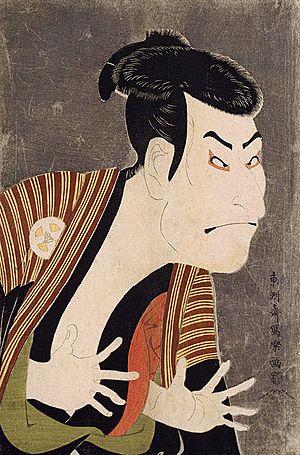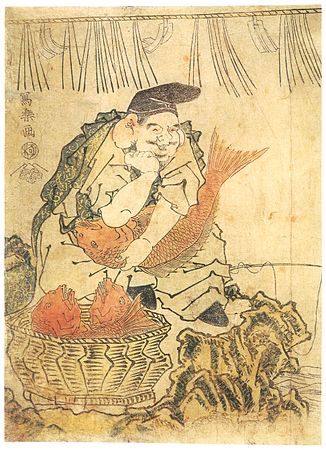Sharaku facts for kids
Tōshūsai Sharaku (Japanese: 東洲斎 写楽; active 1794–1795) was a Japanese ukiyo-e print designer, known for his portraits of kabuki actors. Neither his true name nor the dates of his birth or death are known. His active career as a woodblock artist spanned ten months; his prolific work met disapproval and his output came to an end as suddenly and mysteriously as it had begun. His work has come to be considered some of the greatest in the ukiyo-e genre.
Sharaku made mostly yakusha-e portraits of kabuki actors. His compositions emphasize poses of dynamism and energy, and display a realism unusual for prints of the time—contemporaries such as Utamaro represented their subjects with an idealized beauty, while Sharaku did not shy from showing unflattering details. This was not to the tastes of the public, and the enigmatic artist's production ceased in the first month of 1795. His mastery of the medium with no apparent apprenticeship has drawn much speculation, and researchers have long tried to discover his true identity—amongst the dozens of proposals, some suggest he was an obscure poet, others a Noh actor, or even the ukiyo-e master Hokusai.
Background
Ukiyo-e art flourished in Japan during the Edo period from the 17th to 19th centuries. The artform took as its primary subjects kabuki actors and others associated with the ukiyo "floating world" lifestyle of the pleasure districts. Alongside paintings, mass-produced woodblock prints were a major form of the genre. Ukiyo-e art was aimed at the merchants at the bottom of the social scale, especially of the administrative capital of Edo (modern Tokyo). Its audience, themes, aesthetics, and mass-produced nature kept it from consideration as serious art.
After the mid-18th century, full-colour nishiki-e prints became common, printed with a large number of woodblocks, one for each colour. Critics have come to see the late 18th century as a peak period in the general quality of the work. Shunshō of the Katsukawa school introduced the ōkubi-e "large-headed picture" in the 1760s. He and other members of the Katsukawa school popularized ōkubi yakusha-e actor prints and the dusting of mica in the backgrounds to produce a luxurious glittering effect. In contrast to earlier actor prints, which used stereotyped features and poses of anonymous actors, these ōkubi yakusha-e aimed for recognizable likenesses.
Tōshūsai Sharaku's works appeared in the middle of the Kansei era (1789–1801), when the nation faced hard economic times that the military government responded to with reactionary policies such as the Kansei Reforms intended to strengthen the feudalistic shogunal system. Some of the policies restricted extravagant fashions, and Kabuki theatres faced strict control over their perceived excesses and limits on actors' incomes. Late Edo-period art nevertheless flourished, and new works and popular actors continued to rapidly appear in kabuki theatre, where realistic performances came in vogue. Yakusha-e came to favour a greater emphasis on the individuality of the actors, and buyers came to expect pictures with the actors' likenesses, rather than the stereotyped images of the past, such as those by the once-dominant Torii school.
Works
Over 140 prints have been established as the work of Sharaku; the majority are portraits of actors or scenes from kabuki theatre, and most of the rest are of sumo wrestlers or warriors. The prints appeared in the common print sizes aiban, hosoban, and ōban. They are divided into four periods. The prints of the first two periods are signed "Tōshūsai Sharaku", the latter two only "Sharaku". The print sizes became progressively smaller and the focus shifts from busts to full-length portraits. The depictions become less expressive and more conventional. Two picture calendars dating to as early as 1789 and three decorated fans as late as 1803 have been attributed to Sharaku, but have yet to be accepted as authentic works of his. Sharaku's reputation rests largely on the earlier prints; those from the eleventh month of 1794 and after are considered artistically inferior.
First period
28 ōban prints make up the first period from the fifth month of Kansei 6 (in 1794). They depict actors from kabuki plays performed at three theatres: Hana-ayame Bunroku Soga at the Miyako-za; Katakiuchi Noriyaibanashi and the jōruri Hana-shōbu Omoi no Kanzashi at the Kiri-za; and the kiri-kyōgen Yoshitsune Senbon Zakura at the Kawarazaki-za. These prints are ōkubi yakusha-e against black mica backgrounds, made with a precise, fine line and simple colour scheme. There are printing variants of these early prints, suggesting they went through multiple printings and thus sold relatively well.
- First-period kabuki portraits
Second period
8 ōban and 30 hosoban prints make up the second period from the seventh and eighth months of Kansei 6 (1794). 16 prints are from the jidai-kyōgen Keisei Sanbon Karasaka at Miyako-za in the seventh month; 10 from Nihon Matsu Michinoku Sodachi and the jōruri Katsuragawa Tsuki no Omoide at the Kawarazaki-za in the seventh month; 11 from the jidai-kyōgen Shinrei Yaguchi no Watashi, Yomo no Nishiki Kokyō no Tabiji, and the jōruri Tsuki no Mayu Koi no Monaka at the Kiri-za in the eighth month; and one portrait of Shinozuka Uraeimon as the announcer at Miyako-za.
Of the 8 ōban prints, 7 are full-length portraits of pairs of actors; the other is of the announcer at Miyako-za—the only full-body yakusha-e of a single subject in Sharaku's œuvre. The only one of these ōban prints to employ black mica is that of Ichikawa Komazō III as Kameya Chūbei and Nakayama Tomisaburō as Umegawa from Tsuki no Mayu Koi no Monaka. The hosoban prints are all full-body portraits of a single actor against a yellowish background, with the exception of the portraits of Ōtani Oniji II as Kawashima Jibugorō and Ichikawa Omezō I as Tomita Hyōtarō, which are on grey backgrounds.
- Second-period prints
Third period
47 hosoban, 13 aiban, and 4 ōban prints make up the third period (1794–1795). From the eleventh month of Kansei 6, 18 of the prints come from Oshukubai Koi no Hatsune at the Miyako-za; 21 from Otokoyama Oedo no Ishizue and the jōruri Shinobu Koi Suzume no Irodoki at the Kiri-za; 15 from Matsuhamisa Onna Kusunoki and the jōruri Kagurazuki Iwai no Iroginu at the Kawarazaki-za; 4 are of sumo wrestlers, one of which is a triptych; and two are a memorial to Ichikawa Monnosuke II. From the intercalary 11th month, 3 prints are from Hana no Miyako Kuruwa no Nawabari at the Miyako-za. By this period the artistry in Sharaku's work has noticeably deteriorated and displays less of Sharaku's individual touch.
Most of the hosoban prints distinguish themselves in Sharaku's œuvre by having backgrounds of trees or other stage scenery, though a few have empty yellowish ones. Sharaku focuses on transitional poses as before, but the busier designs weaken the effect by drawing attention away from the actors' expressions to other elements of the composition. Most of the aiban prints are more typically Sharaku in that they focus on the upper body and facial expressions against an empty background, this time yellowish.
- Third-period prints
Fourth period
10 hosoban and 5 aiban prints make up the fourth period from the first month of Kansei 7 (1795). 3 prints come from Nido no Kake Katsuiro Soga at the Kiri-za; 7 from Edo Sunago Kichirei Soga and Godairiki Koi no Fūjime at the Miyako-za; 1 is a sumo print; 2 are musha-e warrior prints; and 1 is of the god of luck Ebisu.
- Fourth-period prints
Identity
Ukiyo-e artists had low social status, and what personal details remain in the record tend to be sparse; Sharaku nevertheless presents an exceptional case in the utter absence of these details. Biographers have long searched, but have had no luck in shining light on the identity of Sharaku. The popularity the prints have attained feeds interest in the mystery, which in turns contributes further to interest the prints. Of the more than fifty theories proposed, few have been taken seriously, and none has found wide acceptance.
A book on haiku theory and aesthetics from 1776 includes two poems attributed to a Sharaku, and references to a Nara poet by the same name appear in a 1776 manuscript and a 1794 poetry collection. No evidence aside from proximity in time has established a connection with the artist Sharaku. A Shinto document of 1790 records the name Katayama Sharaku as husband of a disciple of the sect in Osaka. No further information is known of either the disciple or her husband. A resemblance of Sharaku's kinetic kabuki portraits to those of Osaka-based contemporaries Ryūkōsai and Nichōsai has further fueled the idea of an Osaka-area origin.
Rare calendar prints from 1789 and 1790 that bear the pseudonym "Sharakusai" have surfaced; that they may have been by Sharaku has not been dismissed, but they bear little obvious stylistic resemblance to Sharaku's identified work.
Though disputed, Sharaku's prints have been said to resemble the masks of Noh theatre; connections have been deduced from numerous documents that suggest to some researchers that Sharaku was a Noh actor serving under the lord of Awa Province, in modern Tokushima Prefecture. Amongst these documents are those that suggest Sharaku died between 1804 and 1807, including a Meiji-era manuscript that specifies the seventeenth day of the fifth month of 1806, and that his grave was marked in Kaizenji Temple in Asakusa in Edo. Other similar theories, some discredited, include those that Sharaku was Noh actor Saitō Jūrōbei, Harutō Jizaemon, or Harutō Matazaemon.
In 1968 Tetsuji Yura proposed that Sharaku was Hokusai. The claim is also found in the Ukiyo-e Ruikō ("Various Thoughts on Ukiyo-e"), and Sharaku's prints came during an alleged period of reduced productivity for Hokusai. Though known primarily for his landscapes of the 19th century before Sharaku's arrival Hokusai produced over a hundred actor portraits—an output that ceased in 1794. Hokusai changed his art name dozens of times throughout his long career—government censorship under the Kansei Reforms may have motivated him to choose a name to distance his actor portraits from his other work. As ukiyo-e artists normally do not carve their own woodblocks, a change in carver could explain differences in line quality.
Others proposed identities include Sharaku's publisher Tsutaya or Tsutaya's father-in-law; the artists Utamaro, Torii Kiyomasa, Utagawa Toyokuni, or Maruyama Ōkyo; the painter-poet Tani Bunchō; the writer Tani Sogai; an unnamed Dutch artist; or actually three people. Yet another proposed identity is the author Santō Kyōden; Tani Minezō points out that Sharaku's brief career is concurrent with Kyōden's temporary break from writing gesaku due to grief over the sudden death of his wife Kikuzono around 1793.
See also
 In Spanish: Tōshūsai Sharaku para niños
In Spanish: Tōshūsai Sharaku para niños





















